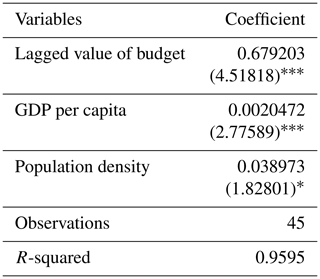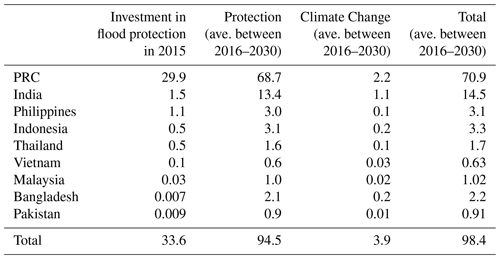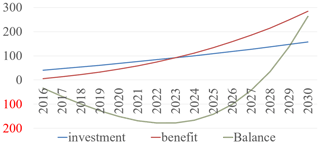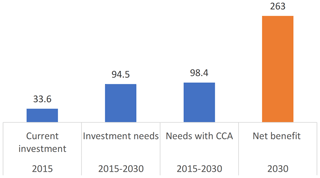the Creative Commons Attribution 4.0 License.
the Creative Commons Attribution 4.0 License.
Investing in Resilience: Estimating Financial Needs and Benefits of Flood Protection in Developing Asian Countries
Mikio Ishiwatari
Daisuke Sasaki
Investment in disaster risk reduction, which the Sendai Framework for Disaster Risk Reduction highlights as a priority action, is crucial in mitigating disaster damage. This paper aims to estimate the funding gap and the benefits of investments in flood protection infrastructure in Asia. Budget and damage data were collected from major flood-prone economies in the region. Currently, nine economies invested USD 33.6 billion, or 0.21 % of GDP, in flood protection. Regression analysis indicates that the annual demand for flood protection infrastructure in developing economies will be USD 94.5 billion by 2030, or USD 98.4 billion considering impacts by climate change. Investment in flood protection is cost-effective at the regional level. If these developing economies could invest this amount, the net benefit (benefits minus costs) accumulation is projected to reach USD 263 billion by 2030.
- Article
(419 KB) - Full-text XML
- BibTeX
- EndNote
Investment is a critical factor in decreasing damages and losses and reducing disaster risks. International arenas have consistently recommended an increase in investment for disaster risk reduction (DRR). The Sendai Framework for DRR, adopted by UN Member States in 2015, highlights investment as a priority action to effectively reduce disaster risks and losses (UNISDR, 2015). The Copenhagen Accord, established in 2009 at the Conference of the Parties to the United Nations Framework Convention on Climate Change, set a target of USD 100 billion yr−1 by 2020 for developed countries to support mitigation and adaptation measures. Despite efforts like the establishment of the Green Climate Fund, this goal remains unmet. The Kumamoto Declaration, adopted at the 4th Asia-Pacific Water Summit in 2022, emphasized the significance of investment and the need to double investment efforts to address water-related challenges.1
Despite these recommendations, increasing investment levels has posed challenges, necessitating a closer examination of investment policies, plans, and financial arrangements. Estimating financial gaps and evaluating investment benefits at regional and national levels in DRR is a complex task compounded by limited availability of budget data and uncertainties associated with climate and social change. Consequently, academic literature in this field is scarce, hindering the development of well-informed investment strategies.
This paper aims to address this research gap by focusing on estimating the financial gaps in flood protection infrastructure and analysing the benefits associated with such investments. It proposes methodologies for estimating the demand for flood protection infrastructure using actual budget data and assessing generated benefits. By bridging the knowledge gap in estimating financial gaps and benefits, this study strives to facilitate evidence-based decision-making in the field of DRR.
Improving our understanding of financial gaps and investment benefits will enable more effective investment policies, plans, and financial arrangements in DRR. Ultimately, this research endeavour aims to enhance the resilience of communities and infrastructure in the face of disasters by informing strategic investment decisions.
Several studies have attempted to calculate the theoretical costs required for adequate flood protection to ensure a specific level of safety. However, these studies have yielded highly diverse results, differing by one to two orders of magnitude (Table 1). The methodologies employed in these studies play a significant role in shaping the outcomes, leading to substantial differences in cost estimations. Also, the scenarios considered, such as different flood magnitudes or varying levels of protection, contribute to the wide range of results.
It is important to note that these studies focus solely on estimating the necessary costs without considering the actual investment that has been made in flood protection. This omission highlights the need to bridge the gap between theoretical cost calculations and real-world investment practices, which this study covers.
3.1 Data collection
Obtaining comprehensive and consistent data on investment in flood protection presents several challenges, as there are no standardized datasets available, and budget data is often not publicly accessible. The definition of flood protection infrastructure may vary across different economies, leading to inconsistencies in the data. It is important to acknowledge these limitations in this study.
To gather data for this research, expert teams visited government offices and examined publicly available data in nine flood-prone economies in developing Asia: Bangladesh, People's Republic of China (PRC), India, Indonesia, Malaysia, Pakistan, Philippines, Thailand, and Vietnam. These economies were selected due to their significant exposure to flood risks. Total population and GDP of the economies account for over 90 % of these total amounts for developing economies in Asia. Budget data for Myanmar were not available for inclusion in this study.
The expert teams collected data on flood-related damage and death tolls from public statistics and disaster management offices. Typically, the economic damage data captured physical damages caused by floods. In cases where government data were unavailable, supplementary datasets were utilized, including SIGMA developed by Swiss Re Institute, NatCatSERVICE developed by Munich RE, and the EM-DAT: Emergency Events Database developed by the Centre for Research on the Epidemiology of Disasters.
All economic data were adjusted to 2015 prices using the GDP deflators to ensure consistency and comparability across the selected years. Population data were sourced from the UN World Population Prospects. Economic indicators such as GDP, per capita GDP, and deflators were obtained from the World Economic Outlook Database.
It is important to acknowledge that this study has certain limitations due to the lack of common datasets on investment in flood protection and the availability of budget data. The absence of standardized reporting frameworks and definitions for flood protection infrastructure across economies further complicates the analysis. For instance, the inclusion of landslide protection and coastal flooding within the category of flood protection varies among different economies, leading to inconsistencies in the data.
3.2 Methods for estimating investments in flood protection
The estimation of demand for flood protection infrastructure employed a regression model utilizing budget data. Equation (1) captures the relationship between various factors:
Where Bi,t is the budget per capita of flood protection in economy ith at time t; yi,t is Gross Domestic Product per capita of economy ith at time t; Popdeni,t is the population density of economy ith at time t; Fi is a fixed effect of economy ith, and ϵi,t is an error term.
To estimate the regression values, a dataset was constructed for a 10-year period from 2006 to 2015, encompassing five economies: PRC, India, Indonesia, Pakistan, and the Philippines. The dataset included variables such as budget, income per capita, shares of agriculture and manufacturing value-added to GDP, urbanization, and population density.
Considering that flood damage is projected to increase in the Asian region due to climate change (Takakura et al., 2019), the demand for flood protection infrastructure is expected to rise as well. Since Eq. (1) does not include damage coefficients, a simplified method was used to estimate the impact of climate change. Equation (2) is an estimate of the average annual budget increase resulting from climate change effects from 2015 to 2030:
Where Ai is the average annual budget increase from climate change effects during 2015–2030 in economy ith; β is the budget increase rate per unit of damage; Ii is the increased ratio of economic damage in the economy ith; and Bi is the average demand of flood protection infrastructure per year in economy ith during 2015–2030 that disregards climate change effects.
The budget increase rate per unit of damage (β) was calculated as 0.5 based on the correlation between budget and damage in the PRC and the Philippines from 2001 until 2015, where both disaster damage and budgets have been increasing in recent years. Alfieri et al. (2017) provided estimates of economic damage caused by river floods globally, incorporating each country's increased ratio of economic damage (Ii). For example, damage in China is estimated to increase by an average of 6 % between 2015 and 2030, while damage in Bangladesh is estimated to increase by 17 %. This estimate does not consider the effect of socioeconomic changes such as population projections, GDP growth, or land use changes.
3.3 Methods for estimating benefits
To estimate the benefits of future investment in flood protection in Asia, this study utilized the actual economic rate of return obtained from flood protection projects supported by the Japan International Cooperation Agency (JICA). JICA, as an implementing agency for Japanese Official Development Assistance, has conducted post-project evaluations for 30 flood protection projects supported by Japanese yen loans. These evaluations include the calculation of an economic internal rate of return for each project, with an average estimated rate of 15.0 % (Ishiwatari, 2016).
The economic internal rate of return represents the discount rate at which the stream of net economic returns, derived by subtracting costs from economic benefits, equals a present value of zero. By analysing the economic internal rate of return, the economic viability and benefits of projects can be assessed. Annual average damage reduction is cumulated based on the flood flow volume. This calculation involved multiplying the damage reduction at a specific flood flow by the probability of its occurrence. The benefits evaluated encompass both direct damage reduction to assets such as houses and factories, as well as indirect damage reduction, including business interruption.
4.1 Investment estimation
The results of the regression analysis estimating the demand for flood protection infrastructure in nine developing economies in Asia are presented in Table 2. The high R-squared value of 0.9595 indicates that the demand increases with the growth of the economy and the population, adding to the previous year's budget. P-values for previous year budget and GDP per capita are at 1 % level of significance, while one for population density is at the 10 % significance level.
The analysis indicates that the total demand for flood protection infrastructure from 2016 to 2030 is projected to reach USD 1417 billion, with an average annual investment requirement of USD 94.5 billion (Table 3).
The share of investment in flood protection as a percentage of GDP is expected to increase from 0.21 % in 2015 to an average of 0.36 % during the period from 2016 to 2030.
The analysis reveals that the demand increased for flood protection infrastructure, considering the increased effects of climate change, is estimated to average USD 3.9 billion yr−1 for the period 2016–2030. This signifies a 4 % increase in demand specifically attributed to the impacts of climate change (Table 3).
4.2 Benefits
The analysis demonstrates that the benefits of investing in flood protection infrastructure exhibit a positive trend over time, with the net benefit accumulation becoming favourable in the later stages of investment (Fig. 1). While the initial costs of implementing flood protection measures may outweigh the immediate benefits, the long-term outcomes show a favourable return on investment. This highlights the potential economic gains and improved resilience that can be achieved by investing in flood protection measures. The analysis reveals that the net benefit, calculated as the difference between the accumulated benefits and costs, turns positive in 2028. By the year 2030, the net benefit accumulation is estimated to reach a substantial value of USD 263 billion.
The financing gap between future demands and current investment levels is around USD 61 billion annually or USD 65 billion when accounting for climate change effects or around 0.24 % of GDP in developing Asia. This amount is similar in magnitude to the World Bank's estimate by Rozenberg and Fay (2019). When the economies invest the amounts estimated, the net benefit accumulation is predicted to reach USD 263 billion in 2030. These findings can provide governments in Asia with evidence to strengthen their investment policies of flood protection. The projected annual demand for flood protection infrastructure, taking climate change into account, emphasizes the critical need for proactive measures to address the evolving risks associated with climate variability and extreme weather events. A significant return on investment affirms the economic viability and value of implementing flood protection measures. While upfront costs may pose initial challenges, the analysis highlights the potential for substantial economic benefits and improved disaster resilience in the future.
To ensure the steady decrease in damages caused by floods, it is crucial for governments to formulate policies that secure the budgets for flood protection in the long term. Integrating DRR into national development plans and formulating multiyear sectoral plans, as observed in the cases of PRC, the Philippines, and Japan, can help secure investment for flood protection (Ishiwatari and Surjan, 2019). Once the governments have confirmed these plans, budgets for flood protection can be allocated steadily every year, although each country's fiscal situation may fluctuate (Ishiwatari, 2021). Establishing a budget line dedicated to DRR is also useful. The Philippines has implemented DRR funds, which offer a dedicated financial resource that both national and local governments can utilize for both preparedness and recovery programs (Government of the Philippines, 2010). This innovative mechanism enables a sustained and continuous investment in DRR initiatives at a predetermined level. By providing a dedicated funding stream, the mechanism empowers governments to allocate resources effectively and consistently to enhance their disaster preparedness and response capabilities.
Innovative approaches, such as nature-based solutions, are needed to decrease costs and achieve sustainability in flood protection. Nature-based solutions, when combined with conventional engineered approaches, have shown to be more cost-effective and provide additional social and environmental benefits. An illustrative example can be found in New York City, where a synergistic blend of nature-based and conventional engineered strategies proves to be highly effective in reducing the cost of flood protection. Research conducted by Browder et al. (2019) demonstrates that this combined approach has the potential to save a substantial USD 1.5 billion, equivalent to a 22 % reduction compared to relying solely on engineered solutions. Beyond cost savings, this approach also yields a multitude of social and environmental benefits, encompassing areas such as fisheries, forestry, ecosystem protection, and recreation, as highlighted by the Global Commission on Adaptation (2019). By emphasizing research and development efforts, governments can further harness the power of innovation to drive down costs associated with DRR initiatives.
Engaging the private sector in financing flood protection is crucial, despite the fact that DRR measures may not yield immediate profits for private companies. Governments need to establish mechanisms that incentivize private sector participation in flood protection, such as incorporating flood mitigation requirements in development projects or requesting private companies to contribute to infrastructure construction. Successful examples, such as the construction of retardation basins in Japan through collaboration with private companies, demonstrate the potential for public-private partnerships in achieving effective flood protection. The Tsurumigawa river basin, located in the Tokyo Metropolitan area, experienced rapid urbanization and the development of residential areas during a period of high economic growth in the 1950s and 60s. To mitigate the risk of flooding in this region, 4700 basins with a total capacity of over 3 million m3 were constructed. These basins serve as essential flood retention structures, effectively managing and controlling the flow of water during heavy rainfall events. As a direct result of these flood protection measures, the number of houses affected by flooding has significantly decreased over the years. In the 1970s, several thousand houses were vulnerable to inundation, whereas in the 1990s and beyond, the number has been reduced to less than one hundred (Ishiwatari, 2016).
It is important to acknowledge the limitations of the methods employed in this study. The demand projection model did not consider non-economic factors such as geographical background and climate conditions, which may influence the demand for flood protection infrastructure. Additionally, the current methods of estimating benefits may not encompass all the benefits associated with flood protection programs, making it challenging to fully evaluate the saving of human lives and the mitigation of long-term indirect impacts.
Budget increases due to climate change impacts have been estimated in a simplified manner. More research is needed on the increase in damage due to climate change and the relationship between the increase in damage and the required budget.
This study estimated investment demand for flood protection infrastructure and its benefits in developing economies in Asia (Fig. 2). The results of the investment estimation analysis demonstrate the scale of investment required to effectively address the demand for flood protection infrastructure. The projected annual investment figures and the percentage of GDP allocated to flood protection underscore the significance of prioritizing and allocating resources towards DRR efforts. The positive net benefit indicates the potential to mitigate damages, enhance asset protection, and strengthen economic stability in the face of flood events.
The demand for flood protection infrastructure in nine developing economies was estimated using a methodology based on multiple regression analysis and time series data. The average annual demand for flood protection in these economies is projected to be USD 94.5 billion for the period 2016–2030. Taking into account the effects of climate change, this amount increases to USD 98.4 billion, representing a 4 % increase. The share of GDP of investment is expected to rise from 0.21 % in 2015 to an average of 0.36 % during the period 2016–2030. There exists a financing gap between the projected future demand and the current investment levels. The estimated annual shortfall is approximately USD 61 billion, or USD 65 billion when considering the impact of climate change. This financing gap represents around 0.24 % of the region's GDP.
The analysis demonstrates that these investments in flood protection are effective. The projected net benefit, calculated as the difference between the benefits and costs, is predicted to accumulate to USD 263 billion by 2030.
These findings highlight the substantial financial commitment required to address the demand for flood protection infrastructure in the region. The estimated investment levels provide valuable insights for policymakers and stakeholders involved in DRR and infrastructure planning, emphasizing the need for substantial financial resources to ensure the resilience and safety of communities in the face of increasing flood risks. By allocating resources effectively and implementing comprehensive flood protection strategies, policymakers and stakeholders can secure substantial economic returns, reduce vulnerability, and enhance the resilience of communities and economies in the face of flood events.
Further research activities should focus on the refinement and enhancement of the models used in this study. It is important to conduct additional studies that revisit the analysis of the benefits derived from investments in flood protection, taking into account the financial and socioeconomic impacts caused by the COVID-19 pandemic. The pandemic has introduced new challenges and uncertainties that may have implications for the effectiveness and economic viability of flood protection measures. The post-pandemic period presents an opportunity to reassess and strengthen investment strategies to ensure long-term resilience against flood risks.
Future research endeavours should cover developing standardized reporting mechanisms of budgets for flood protection and definitions for flood protection infrastructure across economies. This would enable the collection of more robust and comparable data, facilitating more accurate assessments of investment needs and outcomes. Collaboration among governments, international organizations, and research institutions is essential in establishing common frameworks and data-sharing protocols to enhance the accuracy and reliability of future analyses.
The datasets generated and analysed during the current study are available from the corresponding author on reasonable request.
MI and DS substantially contributed to the study conceptualization. MI significantly contributed to data analysis and interpretation, and the manuscript drafting. Both authors critically reviewed and revised the manuscript draft and approved the final version for submission.
The contact author has declared that neither of the authors has any competing interests.
Publisher's note: Copernicus Publications remains neutral with regard to jurisdictional claims made in the text, published maps, institutional affiliations, or any other geographical representation in this paper. While Copernicus Publications makes every effort to include appropriate place names, the final responsibility lies with the authors.
This article is part of the special issue “ICFM9 – River Basin Disaster Resilience and Sustainability by All”. It is a result of The 9th International Conference on Flood Management, Tsukuba, Japan, 18–22 February 2023.
During the preparation of this work the authors used ChatGPT in order to edit English. After using this tool/service, the authors reviewed and edited the content as needed and take full responsibility for the content of the publication.
This paper was edited by Christophe Cudennec and reviewed by two anonymous referees.
Alfieri, L., Bisselink, B., Dottori, F., Naumann, G., de Roo, A., Salamon, P., Wyser, K., and Feyen, L.: Global projections of river flood risk in a warmer world, Earth's Future, 5, 171–182, https://doi.org/10.1002/2016EF000485, 2017.
Browder, G., Ozment, S., Bescos, I. R., Gartner, T., and Lange, G. M.: Integrating Green and Gray: Creating Next Generation Infrastructure, Washington DC: World Bank, World Resource Institute, http://hdl.handle.net/10986/31430 (last access: 4 March 2024), 2019.
Global Commission on Adaptation (GCA): Adapt Now: A Global Call for Leadership on Climate Resilience, Rotterdam, GCA, https://gca.org/reports/adapt-now-a-global-call-for-leadership-on-climate-resilience/ (last access: 4 March 2024), 2019.
Government of the Philippines: Philippine Disaster Risk Reduction and Management Act, Republic Act No. 10121, https://www.officialgazette.gov.ph/2010/05/27/republic-act-no-10121/ (last access: 4 March 2024), 2010.
Hallegatte, S., Green, C., Nicholls, R. J., and Corfee-Morlot, J.: Future flood losses in major coastal cities, Nat. Clim. Change, 3, 802–806, 2013.
Hinkel, J., Lincke, D., Vafeidis, A. T., Perrette, M., Nicollos, R. J., Tol, R. S. J., Marzeion, B., Fettweis, X., Ionescu, C., and Levermann, A.: Coastal flood damage and adaptation costs under 21st century sea-level rise, P. Natl. Acad. Sci. USA, 111, 3292–3297, 2014.
Ishiwatari, M.: How Disaster Resilience Can Contribute to Quality Growth Challenges Facing Disaster Risk Reduction Assistance, Tokyo, JICA Research Institute, https://jicari.repo.nii.ac.jp/records/912 (last access: 4 March 2024), 2016.
Ishiwatari, M.: Disaster Risk Reduction, in: Handbook of Climate Change Mitigation and Adaptation, edited by: Lackner, M., Sajjadi, B., and Chen, W. Y., New York, Springer, 2021.
Ishiwatari, M. and Sasaki, D.: Bridging the Gaps in Infrastructure Investment for Flood Protection in Asia, JICA Ogata Research Institute, https://www.jica.go.jp/Resource/jica-ri/publication/workingpaper/l75nbg0000199ldy-att/JICA-RI_WP_No.202.pdf (last access: 4 March 2024), 2020
Ishiwatari, M. and Sasaki, D.: Investments in flood protection: Trends in flood damage and protection in growing Asian economies, JICA Ogata Research Institute, https://www.jica.go.jp/Resource/jica-ri/publication/workingpaper/l75nbg000019v5g3-att/JICA_Ogata_Research_Institute_WP_No221.pdf (last access: 4 March 2024), 2021.
Ishiwatari, M. and Surjan, A.: Good Enough Today is not Enough Tomorrow: Challenges of Increasing Investments in Disaster Risk Reduction and Climate Change Adaptation, Prog. Disaster Sci., 1, 100007, https://doi.org/10.1016/j.pdisas.2019.100007, 2019.
Rozenberg, J. and Fey, M. (Eds.): Beyond the Gap: How Countries Can Afford the Infrastructure They Need while Protecting the Planet, Sustainable Infrastructure Series, Washington, DC, World Bank, http://documents.worldbank.org/curated/en/189471550755819133/ Beyond-the-Gap-How-Countries-Can-Afford-the-Infrastructure-They-Need-while-Protecting-the-Planet (last access: 4 March 2024), 2019.
Takakura, J., Fujimori, S., Hanasaki, N., Hasegawa, T., Hirabayashi, Y., Honda, Y., Iizumi, To, Kumano, N., Park, C., Shen, Z., Takahashi, K., Tamura, M., Tanoue, M., Tsuchida, K., Yokoki, H., Zhou, Q., Oki, T., and Hijioka, Y.: Dependence of economic impacts of climate change on anthropogenically directed pathways, Nat. Clim. Change, 9, 737–741, https://doi.org/10.1038/s41558-019-0578-6, 2019.
United Nations International Strategy for Disaster Reduction (ISDR): Sendai Framework for Disaster Risk Reduction 2015–2030, Geneva, UNISDR, https://www.preventionweb.net/files/43291_sendaiframeworkfordrren.pdf (last access: 4 March 2024), 2015.
Ward, P. J., Pauw, P., Brander, L. M., Aerts, J. C. J. H., and Strzepek, K. M.: Costs of Adaptation Related to Industrial and Municipal Water Supply and Riverine Flood Protection, Climate change discussion paper No. 6, Washington DC, World Bank, http://documents.worldbank.org/curated/en/313221468326686038/ Costs-of-adaptation-related-to-industrial-and-municipal-water-supply-and-riverine-flood-protection (last access: 4 March 2024), 2010.
This research is a part of the project “Research on Demand Estimate on Infrastructure in Asia” by the JICA Ogata Research Institute. The contents of this paper were released in JICA Ogata Research Institute working papers (Ishiwatari and Sasaki, 2021, 2020).










